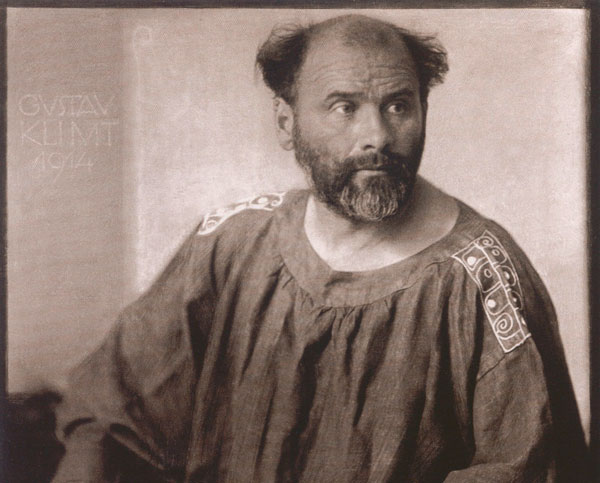1894-1905: Klimt’s Faculty Paintings
(1894-1907)
Seldom has there been a project in Austrian art history that aroused so much opposition from its beginnings. The main building of the University of Vienna, the Alma Mater Rudolfina, was completed in the French-Italian Renaissance style by Heinrich Ritter von Ferstel in 1883 as one of the monumental historicist buildings along the Vienna Ringstrasse. Ferstel had already planned the artistic decorations, but due to a shortage of money and his death in 1884 the project had to be postponed. In 1894 the idea was revisited and Gustav Klimt and Franz Matsch were granted the commission – probably due to their work as the Artists’ Company on the Gründerzeit buildings along the Ringstrasse and several theatres in the Austrian monarchy which had appealed to the public – with an approved budget of 60,000 Guilders (today approximately 400,000 euros).
In 1898 the first draft versions of the central painting and the four faculty paintings were submitted to the artistic committees at the Ministry of Education and the University. Matsch’s design for the central painting “Triumph of Light over Darkness” as well as his design for the faculty painting “Theology” did not raise any objections. Klimt’s designs for the faculty paintings “Medicine”, “Jurisprudence” and “Philosophy”, however, met fierce opposition. Both artists were required to adapt in order to align their all too visibly diverging styles.
In 1898 the first draft versions of the central painting and the four faculty paintings were submitted to the artistic committees at the Ministry of Education and the University. Matsch’s design for the central painting “Triumph of Light over Darkness” as well as his design for the faculty painting “Theology” did not raise any objections. Klimt’s designs for the faculty paintings “Medicine”, “Jurisprudence” and “Philosophy”, however, met fierce opposition. Both artists were required to adapt in order to align their all too visibly diverging styles.
Klimt’s sweeping transition from historicism in the manner of Makart towards Austrian Jugendstil took place between the end of the 1890s and the completion of his world famous painting “The Kiss” in 1907. Time-honoured signs and symbols understood throughout the centuries were abandoned in favour of new artistic solutions. In 1899, almost prophetically, Klimt quoted Friedrich Schiller on his painting “NudaVeritas”: “If you can’t satisfy everyone with your deeds and your art, please a few; to be liked by many is bad.”
Every public presentation of the faculty paintings, which Klimt reworked several times until 1907, unleashed arguments between his patrons and his critics. Writing a petition to the Ministry of Education, the teaching staff of the University came out against attaching the paintings to the ceiling of the University’s ceremonial hall and Klimt’s application to become a professor at the Academy of Applied Arts was rejected. In 1905 Gustav Klimt finally gave up the commission and refunded his remuneration of 30,000 Guilders (today approximately 162,000 Euros) to the Ministry with assistance from his patron August Lederer. His faculty paintings disappeared into public and private collections. In 1943 three of Klimt’s paintings were seen publicly for the last time on the occasion of an exhibition at the Vienna Secession that was organized by the “Reichsstatthalter der Ostmark”. In 1944 the paintings “Philosophy” and “Jurisprudence” found their way into the Austrian Belvedere Gallery as the result of a forced sale. In 1945 they were destroyed in a fire at Immendorf castle in Lower Austria where they had been evacuated to because of the war.
Every public presentation of the faculty paintings, which Klimt reworked several times until 1907, unleashed arguments between his patrons and his critics. Writing a petition to the Ministry of Education, the teaching staff of the University came out against attaching the paintings to the ceiling of the University’s ceremonial hall and Klimt’s application to become a professor at the Academy of Applied Arts was rejected. In 1905 Gustav Klimt finally gave up the commission and refunded his remuneration of 30,000 Guilders (today approximately 162,000 Euros) to the Ministry with assistance from his patron August Lederer. His faculty paintings disappeared into public and private collections. In 1943 three of Klimt’s paintings were seen publicly for the last time on the occasion of an exhibition at the Vienna Secession that was organized by the “Reichsstatthalter der Ostmark”. In 1944 the paintings “Philosophy” and “Jurisprudence” found their way into the Austrian Belvedere Gallery as the result of a forced sale. In 1945 they were destroyed in a fire at Immendorf castle in Lower Austria where they had been evacuated to because of the war.
Hygeia, Detail of Medicine
Gustav Klimt, 1905
Medicine, 1900-1907, destroyed by fire in May 1945 at Immendorf Castle, Lower Austria

Reconstruction of the Ceiling in the Ceremonial Hall
Franz Matsch: Theology, 1900 – 1903, University of Vienna
Philosophy, 1900-1907, destroyed by fire in May 1945 at Immendorf Castle, Lower Austria
Jurisprudence, 1903, destroyed by fire in May 1945 at Immendorf Castle, Lower Austria







